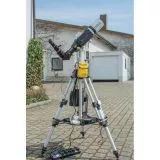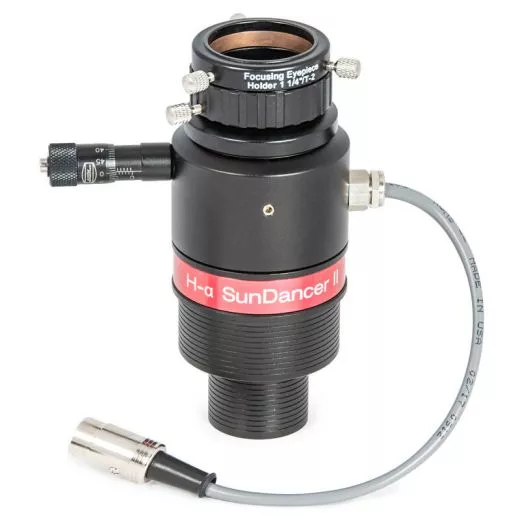- Details
- More images
Products description
Baader sun filter SunDancer II TZ-3S H-alpha 2"/1.25"
Telescopes with secondary mirrors, such as Newtonian, Maksutov or SC telescopes, regardless of their size, definitely require an additional energy protection filter. We recommend using a small refractor for observing the sun with an eyepiece-side filter. This means you are on the safe side. The lack of obstruction of a refracting telescope also more than compensates for the larger aperture of a reflecting telescope. The diffraction on secondary optical components is noticeable when observing the sun (and also the moon and planets) and reduces the resolution.
Our expert comment:
The Skywatcher Apochromatic Refractor AP 80/600 EvoStar ED OTA is very suitable for using the SunDancer II. This apochromat is also a very nice instrument for night observation and astrophotography.
(Stefan Taube)" class="tw-data-text tw-text-large tw-ta" data-placeholder="Übersetzung" data-ved="2ahUKEwjuu4iv7bCJAxV487sIHXLyFN0Q3ewLegQIBxAT" dir="ltr" id="tw-target-text" style="text-align:left">Eyepiece-side filter for solar observation in H-alpha
Very suitable for binoculars
Ideal for solar photography
Integrated 3x telecentricity: For refractors with f/6.5 to f/8
Can be used up to 80mm opening without an additional filter
Baader SunDancer II for observing and photographing the sun
The Baader SunDancer II with heated H-alpha etalon with 23 mm aperture from SolarSpectrum quickly and easily transforms smaller refractors into telescopes for observing the sun in the H-alpha line: Observe the sun's chromosphere with dark filaments, bright flares and spectacular ones Prominences at the edge of the sun!
The SunDancer is simply inserted between the star diagonal and the eyepiece or the camera and connected to a power source. It then automatically heats up to the optimal operating temperature - no readjustment is necessary, even during long observations. The power supply can easily be provided via the included power supply or an optional power tank.
Fine adjustment of the filter passage to adapt to different telescope systems is possible via the control box. The micrometer screw allows the passage to be quickly shifted into the blue wing of the H-alpha line to compensate for the Doppler effect during fast H-alpha events on the Sun.
The Sun in H-alpha: Visual, Photographic and Binocular!
The H-alpha filter has a half-width of 0.6 +/- 0.1 angstrom on telescopes with an aperture ratio of f/10. The integrated telecentricity extends the focal length of the telescope by a factor of three, so that the ideal aperture ratio of f/30 for H-alpha is achieved on telescopes with f/10. The SunDancer II is recommended for telescopes up to around f/8 and can be used well up to around f/6.5; However, on brighter telescopes the half-width increases. The half-width was chosen so that both prominences and the sun's surface are beautifully displayed at the same time.
The entire solar disk can be seen in telescopes with a focal length of up to around 600mm. The T2 thread under the eyepiece clamp allows the adaptation of larger cameras.
The short connection of a binocular attachment via the T2 thread is particularly attractive. In most cases there is no need for a glass path corrector; The telecentricity provides a parallel beam path and at the same time shortens the necessary back focus.
Particularly age-resistant!
The dielectric coating of the 12 millimeter diameter block filter - instead of the usual silver coating - and the airtight etalon filter from SolarSpectrum, which is stored airtight in oil, ensure a high level of durability! If treated correctly, the SunDancer II will maintain its performance for many years.
Please note that the filter - just like any H-alpha filter with Fabry-Pérot-Etalon - must be protected from frost. It must not be stored below 0°C, otherwise the oil mixture will become sulky and push the optical elements apart and damage the coatings. Thermal insulation is required for use at lower temperatures.
Explanation of terms and structure of the H-alpha filter system:
The SunDancer combines three essential components in one housing. Coming from the direction of the telescope, these are the 12 millimeter diameter block filter, a triple telecentric and the actual etalon filter.
The etalon filter is the actual H-alpha filter. As an interference filter, it cancels out all wavelengths except the H-alpha line. Its filter effect depends on the filter thickness and is automatically controlled via the temperature control.
The telecentricity provides the parallel beam path that is necessary for the etalon to function. A Barlow lens or a telescope with f/30 provides the necessary aperture ratio, but not the necessary parallel beam path.
The block filter reflects the incident sunlight just in front of the etalon and the telecentric. This protects the etalon from excessive heat. In addition, an etalon also transmits wavelengths that are multiples of the desired transmission line; these are also blocked by the block filter.
The filter effect of the SunDancer is sufficient for refractors (refracting telescopes) with an aperture of up to 80 millimeters. Larger optics require an additional lens filter: An optional D-ERF energy protection filter is attached in front of the telescope and protects the filter system from unnecessary solar energy by only allowing red light to pass through. D-ERF stands for Dielectric Energy Reflection Filter.
Telescopes with secondary mirrors, such as Newtonian, Maksutov or SC telescopes, regardless of their size, definitely require an additional energy protection filter. We recommend using a small refractor for observing the sun with an eyepiece-side filter. This means you are on the safe side. The lack of obstruction of a refracting telescope also more than compensates for the larger aperture of a reflecting telescope. The diffraction on secondary optical components is noticeable when observing the sun (and also the moon and planets) and reduces the resolution.
Our expert comment:
The Skywatcher Apochromatic Refractor AP 80/600 EvoStar ED OTA is very suitable for using the SunDancer II. This apochromat is also a very nice instrument for night observation and astrophotography.
(Stefan Taube)
Technical data
Performance
Connection (telescopic side)
2"
Connection (eyepiece side)
1.25"
Connection (camera side)
T2
Central wavelength (nm)
656
Half width (angstrom)
0.6
Operating temperature (°C)
0 - (+40)
Suitable for telescope
f/6.5 - f/8 (refractors)
equipment
Power supply
Yes
Transport case
Yes
Generally
type
Solar filter
Construction type
Line filter
This Product was added to our catalogue on 28/03/2024.








